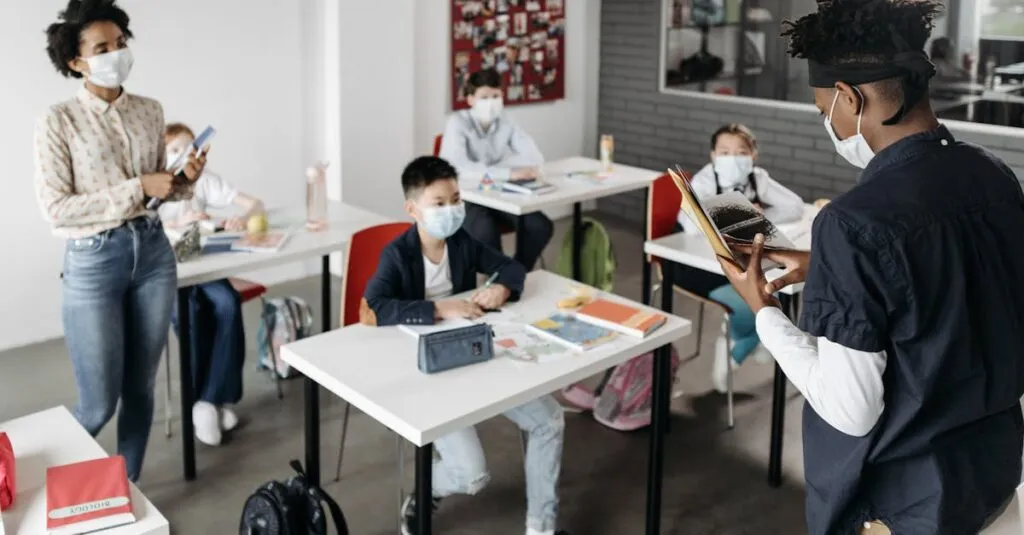Building a Foundation for Forgiveness
In teaching forgiveness, the first step is building a compassionate foundation. Preschoolers are little sponges eager to soak up lessons, especially ones wrapped in love and kindness. Encourage understanding by sharing stories about diverse cultures highlighting respect. It’s like their favorite afternoon snack, but with a side of life lessons!
Use day-to-day interactions to model forgiveness. When you, as a parent, forgive mistakes with warmth, children learn by example. And let’s face it, there will always be spilled milk. Show them that milk can be cleaned up and forgiveness heals faster.
Make your home a no-judgment zone where little hearts feel safe to express guilt and seek forgiveness without fear.

Turning Diversity into Learning Moments
In multicultural settings, every moment offers learning potential. Use differences in culture, language, and traditions to teach patience and empathy toward each other. These are key ingredients for forgiveness!
Celebrate unique holidays and discuss their origins in simple terms, like telling bedtime tales. Encouraging children to share stories about their own traditions fosters respect and awareness.
Teachable Moments
Teachable moments arise when kids ask questions about differences. Turn these queries into dialogues that spark curiosity rather than judgment. This approach makes the whole forgiving thing feel less like a mandate and more like a shared, enjoyable goal.

Understanding Emotions: The Key to Forgiveness
Forgiveness starts with understanding emotions. Kids must recognize feelings to handle them properly. Start by creating an emotional vocabulary with easy words like ‘happy’, ‘sad’, ‘angry’, and ‘forgiving’.
My niece, for instance, called anger her ‘red monster’ and followed with a satisfaction smirk when she ‘sent it away’. Relatable and cute, right?
Encourage kids to discuss times when they feel these emotions and explore forgiveness as a way to handle emotional roller coasters more easily.
Effective Strategies for Encouraging Emotional Discussion
- Create a Vocabulary: Help children learn to express their feelings with simple words.
- Share Personal Stories: Share relatable stories about your own emotional experiences.
- Role-Play: Engage in role-playing activities that allow children to step into each other’s shoes and experience feelings from different perspectives.

Storytime Strategy: Fables with Forgiveness
Storytime isn’t just for bedtimes; it’s also for building forgiving hearts. Choose books with themes of forgiveness and cultural diversity to enrich the experience.
Including tales from The Empty Pot to The Runaway Wok opens doors to rich discussions afterward. These discussions further explore the concept of forgiveness.
Enhancing the Storytelling Experience
Act out stories to make lessons stick. For example, my son often narrates ‘The Boy Who Cried Wolf’ with more dramatic spins than a soap opera actor!
To make storytelling interactive, consider the following:
- Ask questions about how characters might feel.
- Foster emotional insights during discussions.
- Engage in dramatic storytelling to enhance learning.
Bonus: You improve their storytelling skills along the way, too! This approach effectively integrates cultural understanding with lessons on forgiveness.

Games and Activities for Empathy
Games aren’t just fun—they’re a tool for developing empathy and forgiveness. Play activities that reward teamwork and kindness can foster these important skills in children.
1. Forgiveness Yellow Card Game
Have a ‘Forgiveness Yellow Card’ game where kids resolve imaginary disputes for a happy team, echoing sports fields. This not only encourages conflict resolution but also promotes a positive team spirit.
2. Simple Board Games
Introducing simple board games that involve turn-taking and patience can also teach essential social skills needed for forgiving. When kids wait for their turns without jumping the line out of excitement, they learn patience.
3. Lighten the Atmosphere
Laughing at mistakes and ‘retracing steps’ in games not only lightens the atmosphere but also highlights that errors do not define situations. This attitude can help children understand that everyone makes mistakes and that forgiveness is a part of growth.

Incorporating these games into playtime can make a significant difference in developing empathy and forgiveness among children.
Incorporating Music and Art
Music and art express feelings when words don’t come easily. Encourage children to create songs about forgiving memories. Let them turn their apologies into a catchy tune!
Show how cultures express emotions through songs or art. For example, storytelling through indigenous dance can be revealing and enriching.
Creative Projects to Explore Emotions
- Create art projects that explore sorry and thank-you cards, designed with cultural motifs.
- Through creating and appreciating each other’s projects, children learn the significance of emotional expression.
- Engage in fun activities, like roasting marshmallows—oops, I mean embracing diversity!
Through these activities, kids intrinsically learn how art and music integrate with emotional well-being and forgiveness.

Encourage Open Discussions
Forgiveness conversations should be as regular as playtime. Create family forums where everyone gets to express concerns respectfully. Put an ‘Open Talk Hour’ on the calendar. Let each child share stories of when they forgave or were forgiven. It could be about a toy dispute or a snack-tastrophe—it’s the sharing and absorbing that counts.
Engage with multicultural families and have them share forgiving tales from their cultural perspective during these forums. They make the discussions broader and deeper like an enriching potluck.
Encourage children to ask ‘why’ often; it encourages curiosity and leads to greater understanding.

